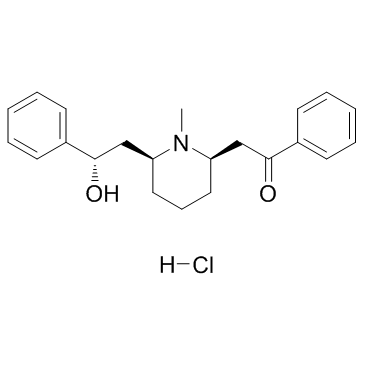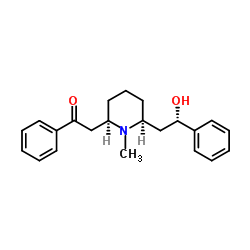α-Lobeline Hydrochcloride

α-Lobeline Hydrochcloride structure
|
Common Name | α-Lobeline Hydrochcloride | ||
|---|---|---|---|---|
| CAS Number | 134-63-4 | Molecular Weight | 373.916 | |
| Density | N/A | Boiling Point | 485.6ºC at 760mmHg | |
| Molecular Formula | C22H28ClNO2 | Melting Point | 183-185 °C (dec.)(lit.) | |
| MSDS | Chinese USA | Flash Point | 247.5ºC | |
| Symbol |

GHS06 |
Signal Word | Danger | |
Use of α-Lobeline HydrochclorideLobeline hydrochloride, a nicotinic receptor agonist, acting as a potent antagonist at both α3β2 and α4β2 neuronal nicotinic receptor subtypes. |
| Name | α-Lobeline Hydrochcloride |
|---|---|
| Synonym | More Synonyms |
| Description | Lobeline hydrochloride, a nicotinic receptor agonist, acting as a potent antagonist at both α3β2 and α4β2 neuronal nicotinic receptor subtypes. |
|---|---|
| Related Catalog |
| Boiling Point | 485.6ºC at 760mmHg |
|---|---|
| Melting Point | 183-185 °C (dec.)(lit.) |
| Molecular Formula | C22H28ClNO2 |
| Molecular Weight | 373.916 |
| Flash Point | 247.5ºC |
| Exact Mass | 373.180847 |
| PSA | 40.54000 |
| LogP | 4.97590 |
| Vapour Pressure | 3.02E-11mmHg at 25°C |
| Index of Refraction | -57.5 ° (C=1, H2O) |
| Storage condition | Store at RT |
| Water Solubility | H2O: 25 mg/mL |
|
Section I.Chemical Product and Company Identification Chemical Name Lobeline Hydrochloride Portland OR SynonymNot available. C22H27NO2•HCl Chemical Formula 134-63-4
CAS Number Section II.Composition and Information on Ingredients Toxicology Data Chemical NameCAS Number Percent (%)TLV/PEL Lobeline Hydrochloride134-63-4Min. 98.0 Not available.Mouse LD50 (intraperitoneal) 39900 (HPLC,T)ug/kg Mouse LD50 (intravenous) 7800 ug/kg Mouse LD50 (subcutaneous) 87500 ug/kg Section III. Hazards Identification Acute Health EffectsToxic if ingested or inhaled. Avoid prolonged contact with this material. Overexposure may result in serious illness or death. Follow safe industrial hygiene practices and always wear proper protective equipment when handling this compound. Chronic Health EffectsCARCINOGENIC EFFECTS : Not available. MUTAGENIC EFFECTS : Not available. TERATOGENIC EFFECTS : Not available. DEVELOPMENTAL TOXICITY: Not available. Repeated exposure to an highly toxic material may produce general deterioration of health by an accumulation in one or many human organs. Section IV.First Aid Measures Eye ContactCheck for and remove any contact lenses. In case of contact, immediately flush eyes with plenty of water for at least 15 minutes. Get medical attention. Skin ContactIn case of contact, immediately flush skin with plenty of water for at least 15 minutes while removing contaminated clothing and shoes. Wash clothing before reuse. Thoroughly clean shoes before reuse. Get medical attention immediately. If the victim is not breathing, perform mouth-to-mouth resuscitation. Loosen tight clothing such as a collar, tie, belt or Inhalation waistband. If breathing is difficult, oxygen can be administered. Seek medical attention if respiration problems do not improve. INDUCE VOMITING by sticking finger in throat. Lower the head so that the vomit will not reenter the mouth and throat. Ingestion Loosen tight clothing such as a collar, tie, belt or waistband. If the victim is not breathing, perform mouth-to-mouth resuscitation. Examine the lips and mouth to ascertain whether the tissues are damaged, a possible indication that the toxic material was ingested; the absence of such signs, however, is not conclusive. Section V.Fire and Explosion Data Not available. May be combustible at high temperature.Auto-Ignition Flammability Flash PointsFlammable LimitsNot available. Not available. These products are toxic carbon oxides (CO, CO2), nitrogen oxides (NO, NO2), halogenated compounds. Combustion Products WARNING: Highly toxic HCl gas is produced during combustion. Fire Hazards Not available. Explosion HazardsRisks of explosion of the product in presence of mechanical impact: Not available. Risks of explosion of the product in presence of static discharge: Not available. Fire Fighting Media SMALL FIRE: Use DRY chemical powder. LARGE FIRE: Use water spray, fog or foam. DO NOT use water jet. and Instructions Consult with local fire authorities before attempting large scale fire-fighting operations. Continued on Next Page Lobeline Hydrochloride Section VI.Accidental Release Measures Spill CleanupToxic material. Stop leak if without risk. DO NOT get water inside container. DO NOT touch spilled material. Use water spray to reduce Instructions vapors. Prevent entry into sewers, basements or confined areas; dike if needed. Eliminate all sources of ignition. Consult federal, state, and/or local authorities for assistance on disposal. Section VII. Handling and Storage TOXIC. Keep locked up.. Keep away from heat. Mechanical exhaust required. When not in use, tightly seal the container Handling and Storage and store in a dry, cool place. Avoid excessive heat and light. DO NOT ingest. Do not breathe dust. Wear suitable Information protective clothing. If ingested, seek medical advice immediately and show the container or the label. Treat symptomatically and supportively. Section VIII. Exposure Controls/Personal Protection Use process enclosures, local exhaust ventilation, or other engineering controls to keep airborne levels below recommended Engineering Controls exposure limits. If user operations generate dust, fume or mist, use ventilation to keep exposure to airborne contaminants below the exposure limit. Splash goggles. Lab coat. Dust respirator. Boots. Gloves. A MSHA/NIOSH approved respirator must be used to avoid Personal Protection inhalation of the product. Suggested protective clothing might not be sufficient; consult a specialist BEFORE handling this product. Exposure LimitsNot available. Section IX. Physical and Chemical Properties Solid. (White powder.)Solubility Physical state @ 20°CSoluble in water, alcohol. Very soluble in chloroform. Not available.Very slightly soluble in ether. Specific Gravity 373.92 Molecular WeightPartition CoefficientNot available. Boiling PointNot available.Vapor PressureNot applicable. 180°C (356°F)Not available. Melting PointVapor Density Not available.VolatilityNot available. Refractive Index Not available. Critical TemperatureNot available.Odor ViscosityNot available.TasteNot available. Section X.Stability and Reactivity Data Stability This material is stable if stored under proper conditions. (See Section VII for instructions) Conditions of InstabilityAvoid excessive heat and light. Incompatibilities Reactive with strong oxidizing agents. Section XI. Toxicological Information OJ8490100 RTECS Number Routes of ExposureEye Contact. Ingestion. Inhalation. Mouse LD50 (intraperitoneal) 39900 ug/kg Toxicity Data Mouse LD50 (intravenous) 7800 ug/kg Mouse LD50 (subcutaneous) 87500 ug/kg Chronic Toxic EffectsCARCINOGENIC EFFECTS : Not available. MUTAGENIC EFFECTS : Not available. TERATOGENIC EFFECTS : Not available. DEVELOPMENTAL TOXICITY: Not available. Repeated exposure to an highly toxic material may produce general deterioration of health by an accumulation in one or many human organs. Acute Toxic EffectsToxic if ingested or inhaled. Avoid prolonged contact with this material. Overexposure may result in serious illness or death. Follow safe industrial hygiene practices and always wear proper protective equipment when handling this compound. Continued on Next Page Lobeline Hydrochloride Section XII.Ecological Information EcotoxicityNot available. Not available. Environmental Fate Section XIII. Disposal Considerations Recycle to process, if possible. Consult your local regional authorities. You may be able to dissolve or mix material with a Waste Disposal combustible solvent and burn in a chemical incinerator equipped with an afterburner and scrubber system. Observe all federal, state and local regulations when disposing of the substance. Section XIV. Transport Information DOT ClassificationDOT CLASS 6.1: Toxic material. PIN Number Proper Shipping NameAlkaloids, solid, n.o.s. III Packing Group (PG) DOT Pictograms Section XV. Other Regulatory Information and Pictograms TSCA Chemical InventoryThis product is NOT on the EPA Toxic Substances Control Act (TSCA) inventory. The following notices are required by 40 CFR 720.36 (C) for those products not on the inventory list: (EPA) (i) These products are supplied solely for use in research and development by or under the supervision of a technically qualified individual as defined in 40 CFR 720.0 et sec. (ii) The health risks of these products have not been fully determined. Any information that is or becomes available will be supplied on an MSDS sheet. WHMIS ClassificationCLASS D-1B: Material causing immediate and serious toxic effects (TOXIC). (Canada) EINECS Number (EEC) 205-150-2 EEC Risk StatementsR23/24/25- Toxic by inhalation, in contact with skin and if swallowed. SECTION 16 - ADDITIONAL INFORMATION N/A |
CHEMICAL IDENTIFICATION
HEALTH HAZARD DATAACUTE TOXICITY DATA
|
| Symbol |

GHS06 |
|---|---|
| Signal Word | Danger |
| Hazard Statements | H301 + H331 |
| Precautionary Statements | P261-P301 + P310-P311 |
| Personal Protective Equipment | Eyeshields;Faceshields;Gloves;type P2 (EN 143) respirator cartridges |
| Hazard Codes | T:Toxic; |
| Risk Phrases | R23/25 |
| Safety Phrases | S36/37/39-S45 |
| RIDADR | UN 1544 6.1/PG 3 |
| WGK Germany | 3 |
| RTECS | OJ8490100 |
| Packaging Group | III |
| Hazard Class | 6.1(b) |
|
~% 
α-Lobeline Hydr... CAS#:134-63-4 |
| Literature: Journal of the American Chemical Society, , vol. 130, # 41 p. 13745 - 13754 |
|
~% 
α-Lobeline Hydr... CAS#:134-63-4 |
| Literature: Organic Letters, , vol. 9, # 17 p. 3237 - 3240 |
|
~% 
α-Lobeline Hydr... CAS#:134-63-4 |
| Literature: Organic Letters, , vol. 9, # 17 p. 3237 - 3240 |
|
~% 
α-Lobeline Hydr... CAS#:134-63-4 |
| Literature: Organic Letters, , vol. 9, # 17 p. 3237 - 3240 |
|
~% 
α-Lobeline Hydr... CAS#:134-63-4 |
| Literature: Organic Letters, , vol. 9, # 17 p. 3237 - 3240 |
|
Enhancing perception of contaminated food through acid-mediated modulation of taste neuron responses.
Curr. Biol. 24(17) , 1969-77, (2014) Natural foods contain not only nutrients, but also nonnutritious and potentially harmful chemicals. Thus, animals need to evaluate food content in order to make adequate feeding decisions.Here, we inv... |
|
|
Chemical genetics reveals a complex functional ground state of neural stem cells.
Nat. Chem. Biol. 3(5) , 268-273, (2007) The identification of self-renewing and multipotent neural stem cells (NSCs) in the mammalian brain holds promise for the treatment of neurological diseases and has yielded new insight into brain canc... |
|
|
The effects of lobeline on nicotine withdrawal-induced depression-like behavior in mice.
Psychopharmacol. Ser. 231(15) , 2989-98, (2014) Evidence suggests that neuronal nicotinic acetylcholine receptor (nAChR) ligand lobeline has antidepressant-like properties.The present study investigated the effects of lobeline on nicotine withdrawa... |
| Ethanone, 2-[(2R,6S)-6-[(2S)-2-hydroxy-2-phenylethyl]-1-methyl-2-piperidinyl]-1-phenyl-, hydrochloride (1:1) |
| 2-[6-(2-Hydroxy-2-phenylethyl)-1-methyl-2-piperidinyl]-1-phenylethanone hydrochloride (1:1) |
| Lobelin hydrochloride |
| Lobeline hydrochloride |
| EINECS 205-150-2 |
| 2-{(2R,6S)-6-[(2S)-2-Hydroxy-2-phenylethyl]-1-methyl-2-piperidinyl}-1-phenylethanone hydrochloride |
| 2-{(2R,6S)-6-[(2S)-2-Hydroxy-2-phenylethyl]-1-methyl-2-piperidinyl}-1-phenylethanone hydrochloride (1:1) |
| MFCD00082455 |
| Ethanone, 2-((2R,6S)-6-((2S)-2-hydroxy-2-phenylethyl)-1-methyl-2-piperidinyl)-1-phenyl-, hydrochloride |
| Ethanone, 2-[6-(2-hydroxy-2-phenylethyl)-1-methyl-2-piperidinyl]-1-phenyl-, hydrochloride (1:1) |
| 2-{(2R,6S)-6-[(2S)-2-Hydroxy-2-phenylethyl]-1-methylpiperidin-2-yl}-1-phenylethanone hydrochloride (1:1) |
| 2-{(2R,6S)-6-[(2S)-2-Hydroxy-2-phenylethyl]-1-methyl-2-piperidinyl}-1-phenylethanonhydrochlorid |
| α-Lobeline hydrochloride |
| (-)-Lobeline hydrochloride |
| 2-{(2R,6S)-6-[(2S)-2-Hydroxy-2-phényléthyl]-1-méthyl-2-pipéridinyl}-1-phényléthanone chlorhydrate |
| 2-(6-(2-Hydroxy-2-phenylethyl)-1-methylpiperidin-2-yl)-1-phenylethanone hydrochloride |
| Lobeline (hydrochloride) |

![(S)-2-[(2R,6S)-6-(2-propionyloxy-2-phenylethyl)-1-methylpiperidin-2-yl]-1-phenylethanone structure](https://image.chemsrc.com/caspic/432/950194-40-8.png)

![Ethanone,2,2'-[(2R,6S)-1-methyl-2,6-piperidinediyl]bis[1-phenyl-, hydrochloride, rel-(9CI) structure](https://image.chemsrc.com/caspic/482/6168-88-3.png)
![2-[6-(2-hydroxy-2-phenylethyl)-1-methylpiperidin-2-yl]-1-phenylethanol structure](https://image.chemsrc.com/caspic/080/552-72-7.png)
 CAS#:90-69-7
CAS#:90-69-7 CAS#:7782-50-5
CAS#:7782-50-5